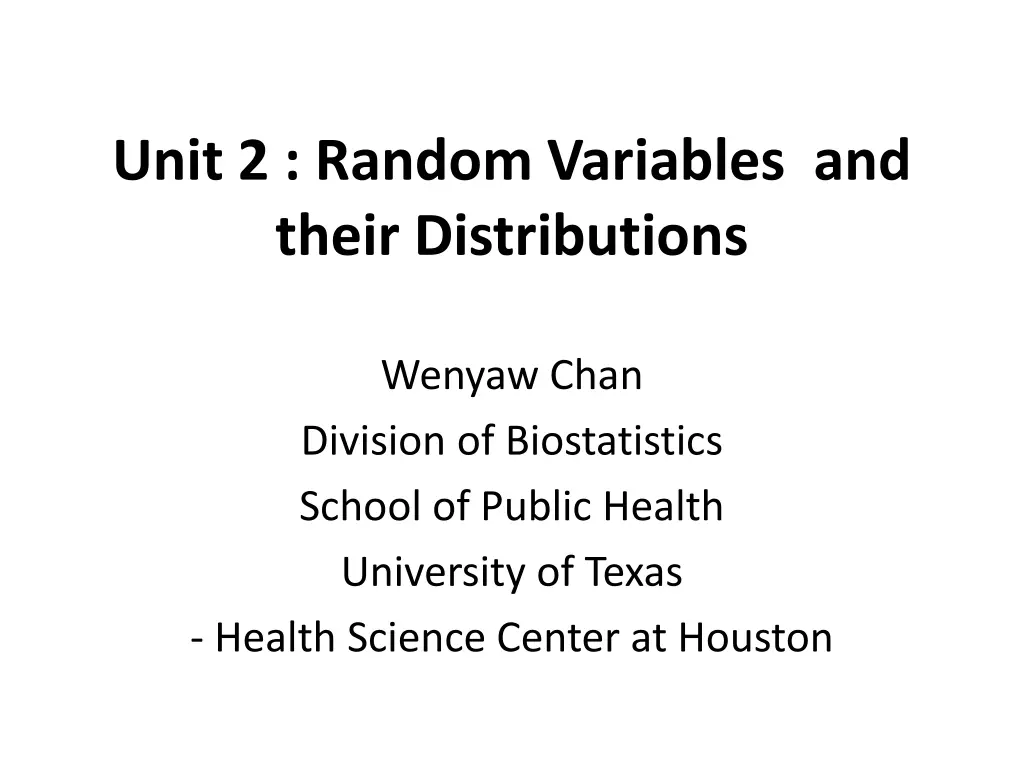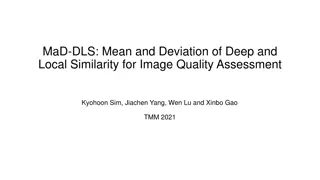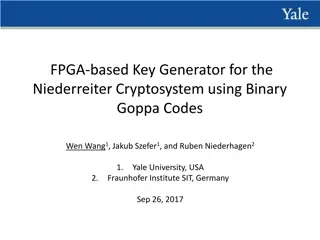
Understanding Random Variables and Distributions in Statistics
Delve into the world of random variables and distributions with a focus on discrete and continuous variables, probability functions, examples, expected value, variance, cumulative distribution function, binomial distribution, and properties of binomial and Poisson distributions. Learn valuable insights and applications in biostatistics and health sciences.
Download Presentation

Please find below an Image/Link to download the presentation.
The content on the website is provided AS IS for your information and personal use only. It may not be sold, licensed, or shared on other websites without obtaining consent from the author. If you encounter any issues during the download, it is possible that the publisher has removed the file from their server.
You are allowed to download the files provided on this website for personal or commercial use, subject to the condition that they are used lawfully. All files are the property of their respective owners.
The content on the website is provided AS IS for your information and personal use only. It may not be sold, licensed, or shared on other websites without obtaining consent from the author.
E N D
Presentation Transcript
Unit 2 : Random Variables and their Distributions Wenyaw Chan Division of Biostatistics School of Public Health University of Texas - Health Science Center at Houston
Random Variable Random Variable: A numeric function that assigns probabilities to different events in a sample. Discrete Random Variable: A random variable that assumes only a finite or denumerable number of values. The probability mass function of a discrete random variable X that assumes values x1, x2, is p(x1), p(x2), ., where p(xi)=Pr[X= xi]. Continuous Random Variable: A random variable whose possible values cannot be enumerated.
Example: Flip a coin 3 times Random Variable X = # of heads in the 3 coin tosses Probability Mass Function P(X=3) = P{(HHH)} =1/8 P(X=2) = P{HHT, HTH, THH}= 3/8 P(X=1) = P{HTT,THT, TTH} = 3/8 P(X=0) = P{TTT} = 1/8 X is a discrete random variable with probability (mass) function x 0 1 2 3 P(X=x) 1/8 3/8 3/8 1/8
Random Variable Expected value of X : k = = = = i ( ) Pr( ) E X x X x i i 1 Variance of X : Var k 2 2 = = = ( ) X = i ( ) Pr( ) X x x i i 1 Standard Deviation of X: = Var (X )
Random Variable Note : Var 2 = = 2 ( ) ( ) X E X 2 ( ) [ ( )] E X E X Cumulative Distribution Function of X : Pr(X<=x) = F(x)
Binomial Distribution Examples of the binomial distribution have a common structure: n independent trials each trial has only two possible outcomes, called success and failure . Pr (success) = p for all trials
Binomial Distribution If X= # of successful trials in these n trials, then X has a binomial distribution. ( ) k n k n k = = 1 ( ) P X k p p k=0,1,2, .,n = n k ! n where n k k ( )! ! Example: Flip a coin 10 times
Properties of Binomial Distribution If X~ Binomial (n, p), then E(X) = np Var (X) = np(1-p)
Poisson Distribution k e ( ) = = Pr X k ! k k=0,1,2, .. If X~ Poisson ( ), then EX = and VarX =
Poisson Process Assumption 1: Pr {1 event occurs in a very small time interval [0, t)} t Pr {0 event occurs in a very small time interval [0, t)} 1- t Pr{more than one event occurs in a very small time interval [0, t)} 0 Assumption 2: Probability that the number of events occur per unit time is the same through out the entire time interval Assumption 3: Pr {one event in [t1,t2) | one event in [t0, t1)} = Pr {one event in [t1, t2)}
Poisson Distribution X=The number of events occurred in the time period t for the above process with parameter , then mean= t and ( ) ( Pr k t k ) e t = = = X k ! where k= 0,1,2, and e= 2.71828 E(X)=Var(X)= t
Poisson approximation to Binomial If X~ Binomial (n, p), n is large and p is small, then e k X P = np k ( ) np ( ) ! k
Continuous Probability Distributions Probability density function (p.d.f.) (of a random variable): a curve such that the area under the curve between any two points a and b, equals Prob[a x b ]= a x bf(x)dx Pr(a<=X<=b) a b
Continuous Probability Distributions Cumulative distribution function: Pr(x a) Pr(X<=a) a
Continuous Probability Distributions The expected value of a continuous random variable X is xf(x)dx, where f(x) is the p.d.f. of X. The definition for the variance of a continuous random variable is the same as that of a discrete random variable, i.e. Var(X)=E(X2)- (EX)2= (x- )2f(x)dx, where =E(X).
The Normal Distribution (The Gaussian distribution) The p.d.f. of a normal distribution 1 ) ( = = x f , - < x < 1 exp 2 ( ) x 2 2 2
The Normal Distribution point of inflection s s u-s u u+s figures: a bell-shaped curve symmetric about Notation: X~N( , 2) : mean 2: variance
The Normal Distribution N(0,1) is the standard normal distribution If X~ N(0,1), then Pr( ) ( x = ) X x ~ : is distributed as , : c.d.f. for the standard normal r.v. Note: The point of inflection is a point where the slope of the curve changes its direction.
Properties of the N(0,1) 1. (-x) = 1- (x) 2. About 68% of the area under the standard normal curve lies between 1 and 1. About 95% of the area under the standard normal curve lies between 2 and 2. About 99% of the area under the standard normal curve lies between 2.5 and 2.5.
Properties of the N(0,1) If X~ N(0,1) and P(X< Zu)=u, 0 u 1 then Zuis called the 100 uthpercentile of the standard normal distribution. 95th%tile=1.645, 97.5th%tile=1.96, 99th%tile=2.33 Area=u Zu
Properties of the N(0,1) If X~ N( , 2), then X ~ (0,1) N This property allows us to calculate the probability of a non-standard normal random variable. a X b = P a X b P r r b a =
Other Distributions--- t distribution Let X1, .Xnbe a random sample from a normal population N( , 2). Then X s n / has a t distribution with n-1 degrees of freedom (df).
Other Distributions--- Chi-square distribution Let X1, .Xnbe a random sample from a normal population N(0, 1). Then n = 2 i X 1 i has a chi-square distribution with n degrees of freedom (df).
Other Distributions--- F distribution Let U and V be independent random variables and each has a chi-square distribution with p and q degrees of freedom respectively. Then / / V q U p has a F distribution with p and q degrees of freedom (df).
Covariance and Correlation The covariance between two random variables is defined by Cov(X,Y)=E[(X- X)(Y- Y)]. The correlation coefficient between two random variables is defined by =Corr(X,Y)=Cov(X,Y)/( X Y).
Variance of a Linear Combination Var(c1X1 + c2X2) 2 1 c c + 2 1 c c + 2 2 X 2 2 = + ( ) ( ) c Var X c Var X 1 2 2 ( , ) Cov X + 1 Var 2 1 2 = ( ) ( ) c X c Var X 1 2 X X 2 ( , ) Corr X 1 2 1 2 Y


![READ [PDF] Scoring Position: Reformed Playboy Romance (Nashville Songbirds Book](/thumb/42222/read-pdf-scoring-position-reformed-playboy-romance-nashville-songbirds-book.jpg)






